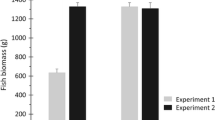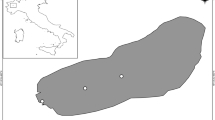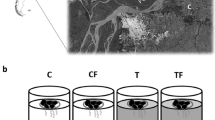Abstract
Protecting and restoring shallow tropical lakes and wetlands requires a knowledge of what shapes and controls algal dynamics and primary productivity in these systems. Algal community structure and composition can be regulated either through biotic or abiotic controls. Large-scale changes in fish populations can affect algal communities by altering food web dynamics and the physical and chemical properties of the aquatic environment. A reduction in fish biomass can lead to a reduction in algal biomass because of increased grazing by zooplankton and reduced availablity of nutrients. However, the omnivorous fish common in tropical systems often consume algae, and their reduction can increase algal biomass. There is a need for more information on the effect of fish removals/reductions in tropical systems. In a five-year study of a shallow, tropical pond in Hawaii, I investigated the water quality effects of tilapia removal following the occurrence of two natural fish die-offs. I describe the concurrent impacts of water-level fluctuations and the fish die-offs on the physical and chemical conditions of the pond and the subsequent changes in the algal community. Overall, nutrients, suspended sediment, organic matter, and algal biomass were significantly reduced and light availability significantly increased in the absence of tilapia.



Similar content being viewed by others
References
Admiraal, W., 1977. Salinity tolerance of benthic estuarine diatoms as tested with a rapid polarographic measurement of photosynthesis. Marine Biology 39: 11–18.
Allende, L., G. Tell, H. Zagarese, A. Torremorell, G. Perez, J. Bustingorry, R. Escaray & I. Izaguirre, 2009. Phytoplankton and primary production in clear-vegetated, inorganic-turbid, and algal-turbid shallow lakes from the pampa plain (Argentina). Hydrobiologia 624: 45–60.
APHA, 1992. Standard Methods for the Examination of Water and Wastewater, 18th ed. American Public Health Association (APHA), American Water Works Association (AWWA) and Water Pollution Control Federation (WPCF), Washington DC.
Arts, M. T., R. D. Robarts, F. Kasai, M. J. Waiser, V. P. Tumber, A. J. Plante, H. Rai & H. J. de Lange, 2000. The attenuation of ultraviolet radiation in high dissolved organic carbon waters of wetlands and lakes on the northern Great Plains. Limnology and Oceanography 45: 292–299.
Attayde, J. L., E. H. van Nes, A. I. L. Araujo, C. Gilberto & M. Scheffer, 2010. Omnivory by planktivores stabilizes plankton dynamics, but may either promote or reduce algal biomass. Ecosystems 13: 410–420.
Beklioglu, M., T. Bucak, J. Coppens, G. Bezirci, U. N. Tavsanoglu, A. I. Cakiroglu, E. E. Levi, S. Erdogan, N. Filiz, K. Ozkan & A. Ozen, 2017. Restoration of eutrophic lakes with fluctuating water levels: A 20-year monitoring study of two inter-connected lakes. Water 9(127): 1–22.
Bothwell, M. L., D. M. J. Sherbot & C. M. Pollock, 1994. Ecosystem response to solar ultraviolet-B radiation: influence of trophic-level interactions. Science 265: 97–100.
Brasil, J., J. L. Attayde, F. R. Vasconcelos, D. D. F. Dantas & V. L. M. Huszar, 2016. Drought-induced water-level reduction favors cyanobacteria blooms in tropical shallow lakes. Hydrobiologia 770: 145–164.
Burian, A., M. Schagerl & A. Yasindi, 2013. Microzooplankton feeding behaviour: grazing on the microbial and the classical food web of African soda lakes. Hydrobiologia 710: 61–72.
Coops, H., M. Beklioglu & T. L. Crisman, 2003. The role of water-level fluctuations in shallow lake ecosystems – workshop conclusions. Hydrobiologia 506–509: 23–27.
Crossetti, L. & C. E. D. M. Bicudo, 2008. Adaptations in phytoplankton life strategies to imposed change in a shallow urban tropical eutrophic reservoir, Garças reservoir, over 8 years. Hydrobiologia 614: 91–105.
Dantas, D. D. F., P. L. Rubim, F. A. de Oliveira, M. R. A. da Costa, C. G. B. Moura, L. H. Teixeira & J. L. Attayde, 2019. Effects of benthivorous and planktivorous fish on phosphorus cycling, phytoplankton biomass and water transparency of a tropical shallow lake. Hydrobiologia 829: 31–41.
Dodds, W. K., 2003. Misuse of inorganic N and soluble reactive P concentrations to indicate nutrient status of surface waters. Journal of the North American Benthological Society 22: 171–181.
Figueredo, C. C. & A. Giani, 2005. Ecological interactions between Nile tilapia (Oreochromis niloticus, L.) and the phytoplanktonic community of the Furnas reservoir (Brazil). Freshwater Biology 50: 1391–1403.
Fox, J. & S. Weisberg, 2018. Time-series regression and generalized least squares in R. An Appendix to: an R Companion to Applied Regression, 3rd ed. Sage, Washington, D.C.
Fulton III, R. S., W. F. Godwin & M. H. Schaus, 2015. Water quality changes following nutrient loading reduction and biomanipulation in a large shallow subtropical lake, Lake Griffin, Florida, USA. Hydrobiologia 753: 243–263.
Gao, J., Z. Liu & E. Jeppesen, 2014. Fish community assemblages changed but biomass remained similar after lake restoration by biomanipulation in a Chinese tropical eutrophic lake. Hydrobiologia 724: 127–140.
Hecky, R. E. & P. Kilham, 1973. Diatoms in alkaline, saline lakes; Ecology and geochemical implications. Limnology and Oceanography 18: 53–71.
Helsel, D. R. & R. M. Hirsch. 2002. Statistical Methods in Water Resources. Techniques of Water-Resource Investigations of the United States Geological Survey, Book 4. Hydrologic Analysis and Interpretation. U. S. Geological Survey. https://pubs.er.usgs.gov/publication/twri04A3
Helsel, D. R., 2005. Non-detects and Data Analysis. Wiley, Hoboken, NJ.
Ibelings, B. W. & S. C. Maberly, 1998. Photoinhibition and the availability of inorganic carbon restrict photosynthesis by surface blooms of cyanobacteria. Limnology and Oceanography 43: 408–419.
Iglesias, C., N. Mazzeo, M. Meerhoff, G. Lacerot, J. M. Clemente, F. Scasso, C. Kruk, G. Goyenola, J. Garcia-Alonso, S. L. Amsinck, J. C. Paggi, S. J. de Paggi & E. Jeppesen, 2011. High predation is of key importance for dominance of small-bodied zooplankton in warm shallow lakes: evidence from lakes, fish exclosures and surface sediments. Hydrobiologia 667: 133–147.
Jeppesen, E., M. Sondergaard, M. Meerhoff, T. L. Lauridsen & J. P. Jensen, 2007. Shallow lake restoration by nutrient loading reduction – some recent findings and challenges ahead. Hydrobiologia 584: 239–252.
Jeppesen, E., S. Brucet, L. Naselli-Flores, E. Papastergiadou, K. Stefanidis, T. Noges, P. Noges, J. L. Attayde, T. Zohary, J. Coppens, T. Bucak, R. F. Menezes, F. R. S. Freitas, M. Kernan, M. Sondergaard & M. Beklioglu, 2015. Ecological impacts of global warming and water abstraction on lakes and reservoirs due to changes in water level and related changes in salinity. Hydrobiologia 750: 201–227.
Kasprzak, P., J. Benndorf, T. Mehner & R. Koschel, 2002. Biomanipulation of lake ecosystems: an introduction. Freshwater Biology 47: 2277–2281.
Kitchell, J. F. & S. R. Carpenter, 1993. Cascading trophic interactions. In Carpenter, S. R. & J. F. Kitchell (eds), The Trophic Cascade in Lakes. Cambridge University Press, New York: 1–14.
Lazzaro, X., M. Bouvy, R. A. Ribeiro-Filho, V. S. Oliviera, L. T. Sales, A. R. M. Vasconcelos & M. R. Mata, 2003. Do fish regulate phytoplankton in shallow eutrophic Northeast Brazilian reservoirs? Freshwater Biology 48: 649–668.
Lewis, W. M., 1996. Tropical lakes: how latitude makes a difference. In Schiemer, F. & K. T. Boland (eds), Perspectives in Tropical Limnology. SPB Academic Publishing, Amsterdam: 43–66.
Loverde-Oliveira, S. M., V. L. M. Huszar, N. Mazzeo & M. Scheffer, 2009. Hydrology-driven regime shins in a shallow tropical lake. Ecosystems 12: 807–819.
Lyman Ott, R. & M. Longnecker, 2015. An Introduction to Statistical Methods and Data Analysis, 7th ed. Cengage Learning, Boston, MA.
Mayer, T. D. & S. L. Pilson, 2019. Interactions of water levels with water quality, endemic waterbirds, and invasive species in a shallow, tropical pond. Hydrobiologia 829: 77–93.
Menezes, R. F., J. L. Attayde & F. R. Vasconcelos, 2010. Effects of omnivorous filter-feeding fish and nutrient enrichment on the plankton community and water transparency of a tropical reservoir. Freshwater Biology 55: 767–779.
Mur, L. R. & H. Schreurs, 1995. Light as a selective factor in the distribution of phytoplankton species. Water Science and Technology 32: 25–34.
Nielson, D. L., M. A. Brock, G. N. Rees & D. S. Baldwin, 2003. Effects of increasing salinity on freshwater ecosystems in Australia. Australian Journal of Botany 51: 655–665.
Okun, N., J. Brasil, J. L. Attayde & I. A. S. Costa, 2008. Omnivory does not prevent trophic cascades in pelagic food webs. Freshwater Biology 53: 129–138.
Ozen, A., B. Karapınar, I. Kucuk, E. Jeppesen & M. Beklioglu, 2010. Drought-induced changes in nutrient concentrations and retention in two shallow Mediterranean lakes subjected to different degrees of management. Hydrobiologia 646: 61–72.
Pace, M. L., J. J. Cole, S. R. Carpenter & J. F. Kitchell, 1999. Trophic cascades revealed in diverse ecosystems. Trends in Ecology & Evolution 14: 483–488.
Peretyatko, A., S. Teissier, S. De Backer & L. Triest, 2012. Biomanipulation of hypereutrophic ponds: when it works and why it fails. Environmental Monitoring and Assessment 184: 1517–1531.
Reynolds, C. S., 1984. The Ecology of Freshwater Plankton. Cambridge University Press, Cambridge.
Reynolds, C. S., 2006. The Ecology of Phytoplankton. Cambridge University Press, Cambridge.
Rodrigues, M., A. da Costa, J. L. Attayde & V. Becker, 2016. Effects of water level reduction on the dynamics of phytoplankton functional groups in tropical semi-arid shallow lakes. Hydrobiologia 778: 75–89.
Rondel, C., R. Arfi, D. Corbin, F. Le Bihan, E. H. Ndour & X. Lazzaro, 2008. A cyanobacterial bloom prevents fish trophic cascades. Freshwater Biology 53: 637–651.
Russell, D. J., P. A. Thuesen & F. E. Thomson, 2012. A review of the biology, ecology, distribution, and control of Mozambique tilapia, Oreochromis mossambicus (Peters 1852) (Pisces: cichlidae) with particular emphasis on invasive Australian populations. Reviews in Fish Biology and Fisheries 22: 533–554.
Scheffer, M., 1998. Ecology of Shallow Lakes, 1st ed. Chapman & Hall, New York.
Sergeant, C. J., E. N. Starkey, K. K. Bartz, M. H. Wilson & F. J. Mueter, 2016. A practitioner’s guide for exploring water quality patterns using principal components analysis and Procrustes. Environmental Monitoring and Assessment 188: 249.
Shapiro, J., 1995. Lake restoration by biomanipulation—a personal view. Environmental Reviews 3: 83–93.
Starling, F., X. Lazzaro, C. Cavalcanti & R. Moreira, 2002. Contribution of omnivorous tilapia to eutrophication of a shallow tropical reservoir: evidence from a fish kill. Freshwater Biology 47: 2443–2452.
Stephen, D., D. M. Balayla, E. Becares, S. E. Collings, C. Fernandez-Alaez, M. Fernandez-Alaez, C. Ferriol, P. Garcia, J. Goma, M. Gyllstrom, L. A. Hansson, J. Hietala, T. Kairesalo, M. R. Miracle, S. Romo, J. Rueda, A. Stahl-Delbanco, M. Svensson, K. Vakkilainen, M. Valentin, W. J. van de Bund, E. van Donk, E. Vicente, M. J. Villena & B. Moss, 2004. Continental-scale patterns of nutrient and fish effects on shallow lakes: introduction to a pan-European mesocosm experiment. Freshwater Biology 49: 1633–1649.
Talling, J. F., 2001. Environmental controls on the functioning of shallow tropical lakes. Hydrobiologia 458: 1–8.
Torres, S. G., L. H. S. Silva, L. M. Rangel, J. L. Attayde & V. L. M. Huszar, 2016. Cyanobacteria are controlled by omnivorous filter-feeding fish (Nile tilapia) in a tropical eutrophic reservoir. Hydrobiologia 765: 115–129.
Watson, S. B., E. McCauley & J. A. Downing, 1997. Patterns of phytoplankton taxonomic composition across temperate lakes of differing nutrient status. Limnology & Oceanography 42: 487–495.
Wetzel, R. G., 2001. Limnology: Lake and River Ecosystems, 3rd ed. Academic Press, New York.
Yu, J., Z. Liu, K. Li, F. Chen, B. Guan, Y. Hu, P. Zhong, Y. Tang, X. Zhao, H. He, H. Zeng & E. Jeppesen, 2016. Restoration of shallow lakes in subtropical and tropical china: response of nutrients and water clarity to biomanipulation by fish removal and submerged plant transplantation. Water 8: 438.
Zhang, X., X. Mei & R. D. Gulati, 2017a. Effects of omnivorous tilapia on water turbidity and primary production dynamics in shallow lakes: implications for ecosystem management. Reviews in Fish Biology and Fisheries 27: 245–254.
Zhang, X., Y. Tang, E. Jeppesen & Z. Liu, 2017b. Biomanipulation-induced reduction of sediment phosphorus release in a tropical shallow lake. Hydrobiologia 794: 49–57.
Zohary, T., J. Padisak & L. Naselli-Flores, 2010. Phytoplankton in the physical environment: beyond nutrients, at the end, there is some light. Hydrobiologia 639: 261–269.
Author information
Authors and Affiliations
Corresponding author
Additional information
Publisher's Note
Springer Nature remains neutral with regard to jurisdictional claims in published maps and institutional affiliations.
Guest editors: Alonso Ramírez, Checo Colon-Gaud, Margarita Caballero & Gabriela Vázquez / Recent Advances in Tropical Lake Research
Rights and permissions
About this article
Cite this article
Mayer, T. Interactions of fish, algae, and abiotic factors in a shallow, tropical pond. Hydrobiologia 847, 4145–4160 (2020). https://doi.org/10.1007/s10750-020-04375-y
Received:
Revised:
Accepted:
Published:
Issue Date:
DOI: https://doi.org/10.1007/s10750-020-04375-y




